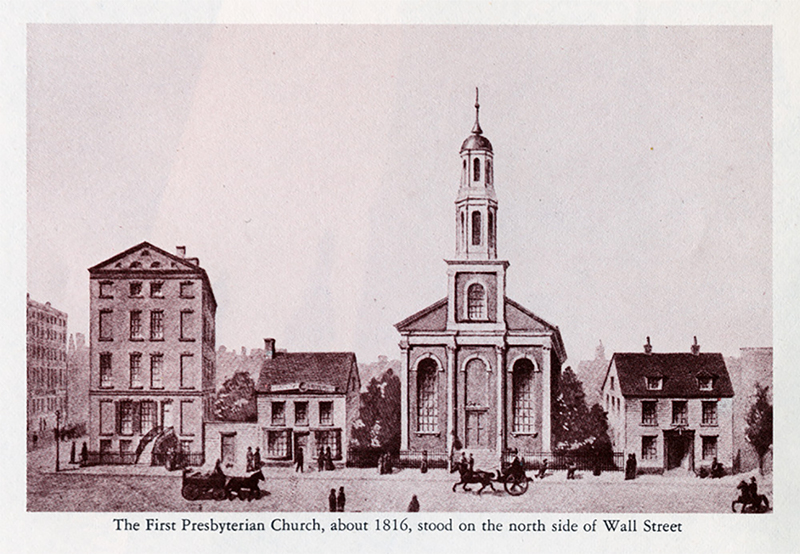
Image provided by PHS, Pearl ID: 15971
David Pultz, archivist at First Church, said, “PHS has been an invaluable resource. Our congregational records stretching back to 1717 are archived there, and on several occasions we have utilized its excellent digitization service. PHS is a true gem.”
The recent digitization project was paid for by the congregation. Learn about digitizing records with PHS in this short video, with First Church information beginning at 1:15.
First Church was established in 1716, and its first building was constructed on Wall Street in 1719. Members of First, fleeing the density of Wall Street and its environs, founded Brick Presbyterian Church in 1768. The expanding membership organized Rutgers Presbyterian Church, on Henry Street, in 1798. In 1835 a massive fire destroyed most of what was then considered Old New York, including the building on Wall Street. Continuing to follow their membership north, First built a new stone structure on Fifth Avenue, and the congregation moved there in 1846. In the 1850s two new Presbyterian churches were organized nearby: University Place and Madison Avenue.
In 1919 the three churches merged, and opted to use Old First's building and name. The newly merged congregation called Rev. Harry Emerson Fosdick to the pulpit in 1919, and in a series of sermons over five years, Rev. Fosdick argued that scientific and religious knowledge were compatible, directly confronting the burgeoning Fundamentalist movement in America's churches. Fosdick's sermon, "Shall the Fundamentalists Win?" sparked a famous rejoinder from Rev. Clarence Macartney at Philadelphia's Arch Street Presbyterian Church, "Shall Unbelief Win?", and the Presbyterian church on a national level was riven with the Modernist-Fundamentalist controversy. The 1923 General Assembly directed the Presbytery of New York City to formally investigate Fosdick; his defense was handled by future secretary of state John Foster Dulles. Rather than face ongoing scrutiny, Fosdick resigned from his pastorate in 1924.
“Fosdick’s sermons, re-read today, sound prescient, as if from 1922 he could see the course of mainline Protestantism over the coming century,” says PHS archivist David Staniunas.
First Church would continue to champion social witness within the denomination, supporting the ordination of women as ministers of word and sacrament in the 1930s, and advocating for the election of Rev. Edler G. Hawkins as the first African American moderator of the UPCUSA in 1961. Rev. J. Barrie Shepherd, pastor from 1992 to 2001, would steward a congregation seeking full rights for gays and lesbians inside the church. First Church remains an open and affirming congregation.
The Presbyterian Historical Society is the national archives of the PC(USA), serving the records of more than 12,000 current and historic churches.
